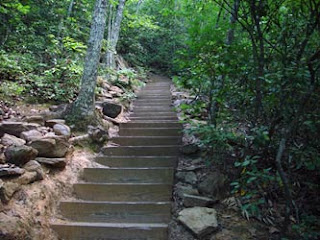The inaugural Grindstone 100 has been billed as the toughest 100 mile race east of the Rockies. It has over 23,000 feet of elevation gain and 90% of it is run on rocky, technical trails. It came with a 38 hour time limit and I was worried that I would spend most of the race chasing cutoffs and using all 38 hours to finish the run. Because this was the inaugural race, I had no data other than the very intimidating trail profile posted on the website. The other race with the claim to being the toughest, the Massanutten, was my first 100, five years ago and it was indeed tough. I finished with only a half hour to spare, 27 blisters and a black eye. I really hoped I would have a better experience at the Grindstone. This race was also unique in that it began at 6:00 p.m. on Friday evening. If you ran over 25 hours, you faced two nights and one day of running, compared to the usual two days and one night. The night running, combined with the rough trails, made for some very slow moving at times.
limit and I was worried that I would spend most of the race chasing cutoffs and using all 38 hours to finish the run. Because this was the inaugural race, I had no data other than the very intimidating trail profile posted on the website. The other race with the claim to being the toughest, the Massanutten, was my first 100, five years ago and it was indeed tough. I finished with only a half hour to spare, 27 blisters and a black eye. I really hoped I would have a better experience at the Grindstone. This race was also unique in that it began at 6:00 p.m. on Friday evening. If you ran over 25 hours, you faced two nights and one day of running, compared to the usual two days and one night. The night running, combined with the rough trails, made for some very slow moving at times.
Thankfully, although the race was very tough, it turned out fine. I think the perfect weather, the exceptionally helpful and supportive volunteers, the well-marked course and the opportunity to have my husband pace me some all combined to make the race challenging, yet doable.
The course was beautiful- the lights of the cities down in the valley at night, the two sunsets, the spectacular sunrise at Reddish Knob.
the cities down in the valley at night, the two sunsets, the spectacular sunrise at Reddish Knob.
Only one hallucination: As it started to get dark on night two, I stopped to dig my lights out of my pack and saw my husband up on the trail ahead waiting for me (he had been running out a couple miles from each aid station and running back in with me). He kept leaning out as if he was trying to see who it was. After I started back again, I found that my 6’, 225 lb husband was actually a fluorescent pink streamer blowing in the wind.

I finished in 31:29, but I had some asthma issues for a good part of the race, so I think if I had that under control I could have finished under 30:00. Just like in any race, I had some very good times and some pretty bad times (it’s amazing how a turkey sandwich can turn things around for you), but all in all, it was an enjoyable run.
As far as the toughest 100 in the east, I really don’t know. The Massanutten was certainly tougher for me, but it was my first 100. Old Dominion this year with the heat and humidity was tougher for me as well- it took everything I had to finish it. I’m just glad I was able to run the Grindstone in ideal conditions.
Thankfully, although the race was very tough, it turned out fine. I think the perfect weather, the exceptionally helpful and supportive volunteers, the well-marked course and the opportunity to have my husband pace me some all combined to make the race challenging, yet doable.
The course was beautiful- the lights of
Only one hallucination: As it started to get dark on night two, I stopped to dig my lights out of my pack and saw my husband up on the trail ahead waiting for me (he had been running out a couple miles from each aid station and running back in with me). He kept leaning out as if he was trying to see who it was. After I started back again, I found that my 6’, 225 lb husband was actually a fluorescent pink streamer blowing in the wind.
I finished in 31:29, but I had some asthma issues for a good part of the race, so I think if I had that under control I could have finished under 30:00. Just like in any race, I had some very good times and some pretty bad times (it’s amazing how a turkey sandwich can turn things around for you), but all in all, it was an enjoyable run.
As far as the toughest 100 in the east, I really don’t know. The Massanutten was certainly tougher for me, but it was my first 100. Old Dominion this year with the heat and humidity was tougher for me as well- it took everything I had to finish it. I’m just glad I was able to run the Grindstone in ideal conditions.








